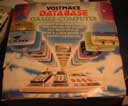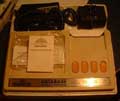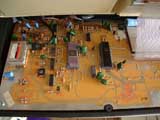
Odd machine, this. Voltmace were a UK based company that made
their name making joysticks for the likes of the BBC Micro. Since this machine
is also marked by Videomaster I'm not sure who actually designed it! Powering
it up with the Invaders cart reveals a surprise - the games are identical to
the ones on consoles made by Radofin! No mention of them anywhere on the board
though, so Voltmace must've designed their own kit round the software; even
the carts aren't physically compatible with the likes of the Acetronic MPU or
TV Master series.
*update*. This is from Derek Andrews, who at
the time was a programmer for Voltmace's own games for the Database - it explains
a lot about the machine itself!
"The company was based in Baldock,
Hertfordshire, UK. It was a small company, probably no more than 12
people. They bought the basic design of the console from another
company, and re-engineered some parts and manufactured them in house.
There was a sister company in the same building who made the pcb's, and
a small assembly line. When they decided that they needed to expand on
the range of cartridges, they had a development system built by another
firm, and I was hired to program the games. The development system was
CPM based, and allowed me to write programs in 2650 assembly language.
It was pretty basic stuff in those days, and I had to be quite creative
to squeeze the most I could get out of the video chip. It basically had
a programmable background, score digits and four objects, each of 8
pixels x 8 pixels. These objects could be reprogrammed on the fly as the
video signal was being output. When an object was completly displayed,
an IRQ was generated which the program would detect and load a new shape
and position (further down the screen) into the object. Thus it was
possible to have many objects on the screen at once, though it made the
programming interesting and placed restrictions on the vertical
positioning of the objects. There wasn't much RAM on board, and some
cartridges contained extra RAM if the game needed it."
Hertfordshire, UK. It was a small company, probably no more than 12
people. They bought the basic design of the console from another
company, and re-engineered some parts and manufactured them in house.
There was a sister company in the same building who made the pcb's, and
a small assembly line. When they decided that they needed to expand on
the range of cartridges, they had a development system built by another
firm, and I was hired to program the games. The development system was
CPM based, and allowed me to write programs in 2650 assembly language.
It was pretty basic stuff in those days, and I had to be quite creative
to squeeze the most I could get out of the video chip. It basically had
a programmable background, score digits and four objects, each of 8
pixels x 8 pixels. These objects could be reprogrammed on the fly as the
video signal was being output. When an object was completly displayed,
an IRQ was generated which the program would detect and load a new shape
and position (further down the screen) into the object. Thus it was
possible to have many objects on the screen at once, though it made the
programming interesting and placed restrictions on the vertical
positioning of the objects. There wasn't much RAM on board, and some
cartridges contained extra RAM if the game needed it."
A previous mail had mentioned an add-on for the ZX81 that allowed
you to program the Database directly:
"The cart had a shared RAM which the zx81 could write to,
and then
the Database could run off of that program. There was a monitor program
(I think that was in EPROM) for the ZX81 which allowed the user to
create the 2650 machine code. "
the Database could run off of that program. There was a monitor program
(I think that was in EPROM) for the ZX81 which allowed the user to
create the 2650 machine code. "
Never seen mention of that anywhere....be interesting
to get my paws on one, if they were ever made. Thanks Derek!
Pictures
 |  |  |  |
 |  |  |  |